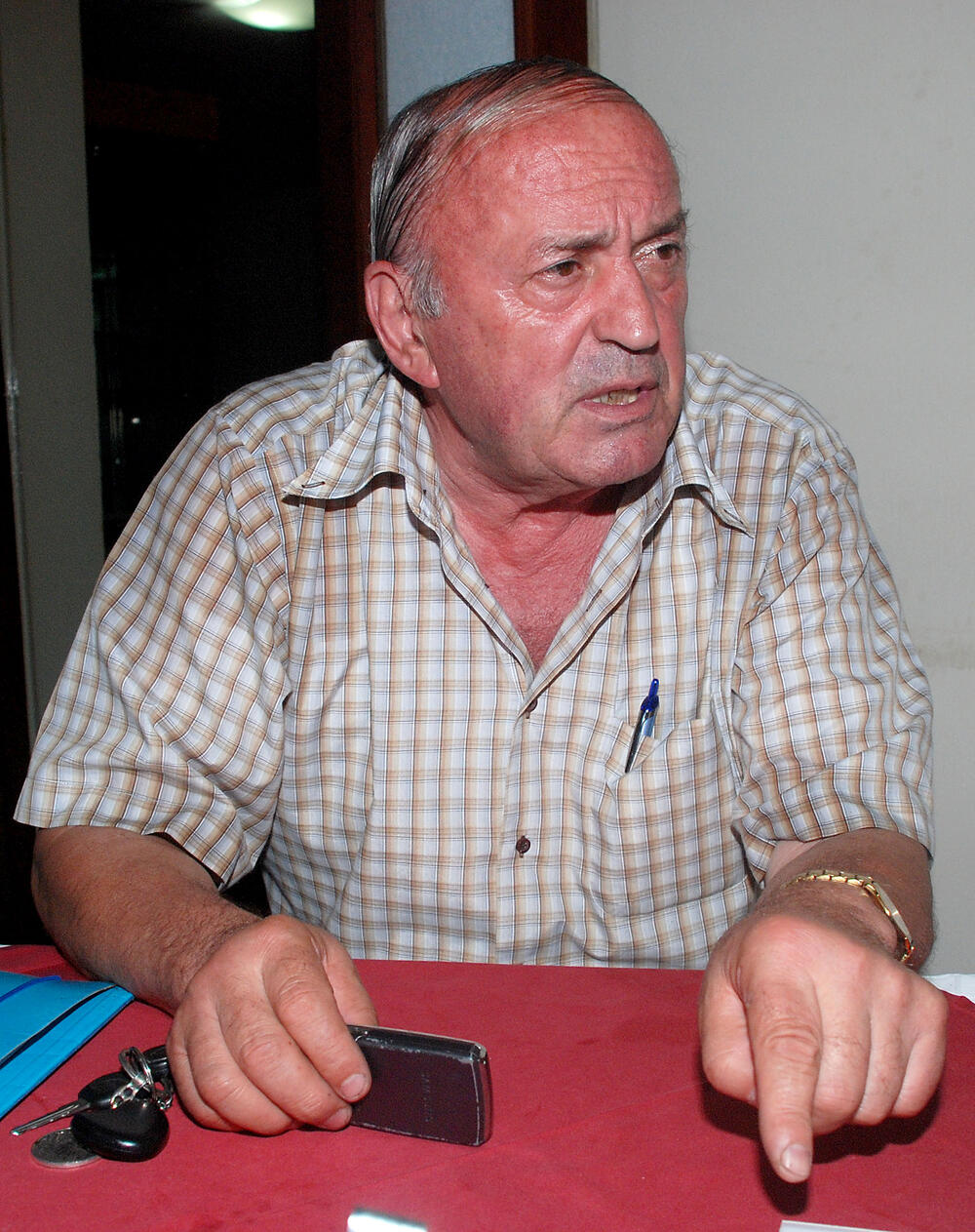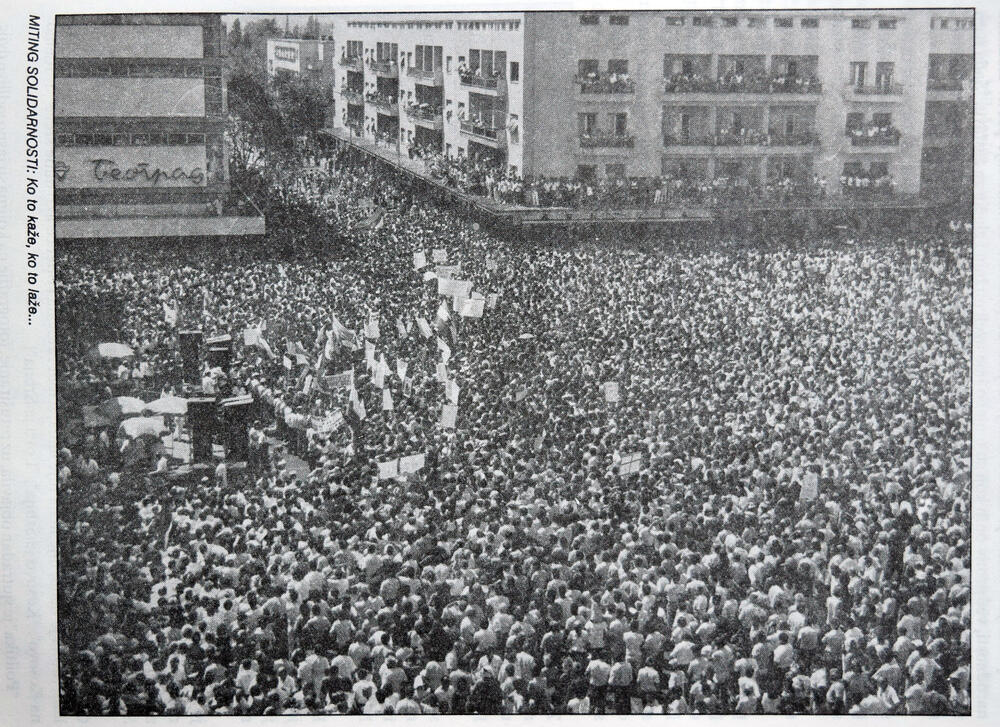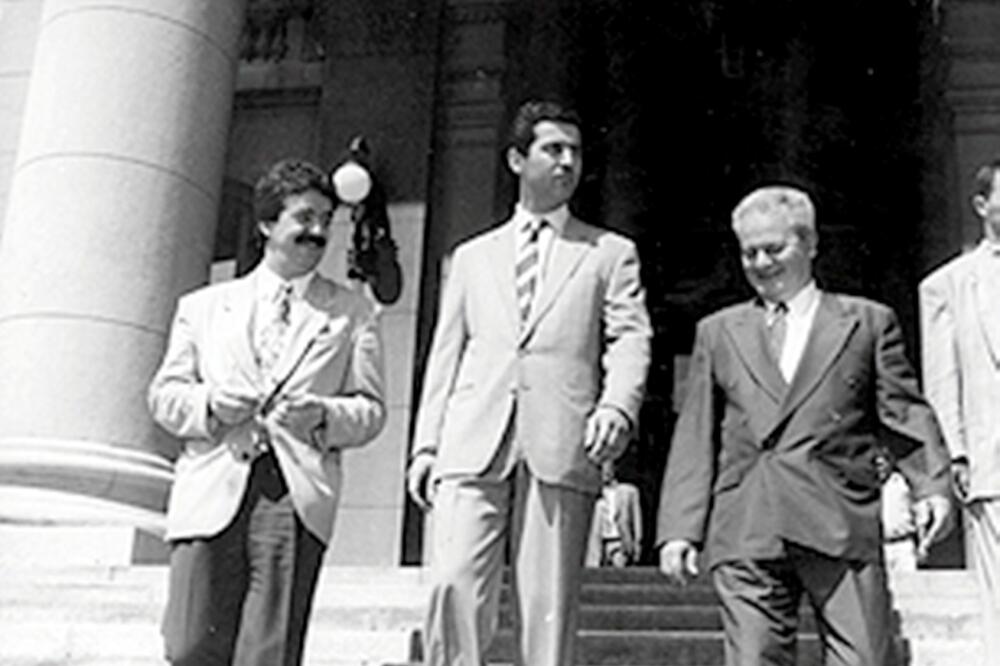On the gloomy morning of October 8, 1988, it was raining lightly, and the south wind and fog shortly after 10 o'clock mixed with tear gas, which the special units of the republican SUP fired in order to try to stop the workers in the town of Žuta greda - the strait on the highway Nikšić Ironworks "Boris Kidrič" to reach Titograd...
It was the first time in post-war history in a solid one-party system that the Montenegrin militia calmed down the rebel workers with force and tear gas, and the Yellow Beam became a symbol of suffering from the "unpopular regime".
The incident near Žuta greda, in which four employees of the Ironworks were seriously injured in a police action, only fueled the popular rebellion, which, with the skillful political-nationalist influence from Serbia in the AB revolution, led to a political coup three months later...
About the clash between the militia and metalworkers from Nikšić near Žuta greda, where special forces created a blockade for the workers and then showered them with tear gas, there are testimonies from ironworkers, as well as official notes filed in the then SUP and the State Security Service.
The director of the Željezara at the time, Vojin Đukanović, recalled for "Vijesti" the October events of 32 years ago, but also the journey to Žuta Greda after he heard that "something had happened with the workers"...
“I remember, it was a rainy day. Some light rain and a very gloomy day. The workers of the third and first shift, as well as those who spent the night at the meeting in front of the Assembly, headed for Titograd, and I stayed at the Ironworks. However, the president of Nikšić Municipality, Stevo Goranović, called me, sometime around 11 o'clock, he said: 'Director, something happened with the workers, it would be good if you could get in touch'. Banjo Bulajić, as the president of the entire Combine, was then officially in Spain, and he was replaced by Mišo Čaušević. I invited him to go together to see what happened. When we got to Bogetić, we were stopped by special forces, who blocked the road to Titograd. They told us that they could not pass, even though I am the director of the Ironworks, so they instructed us to take the old road to Danilovgrad. When we took the highway from Danilovgrad to Nikšić, the militia stopped us again, but they let us go. We met the workers before the last tunnel, they were walking. Several scenes stuck out to me - many were carrying broken umbrellas, and one had a broken large picture of Tito around his neck, just hanging the frame. When I asked them what it was, they told me that the special forces attacked them with tear gas and that there were injured and also dead down that side," Đukanović recalled the famous event.

The season of Montenegrin "solidarity rallies" that began in the summer of 1988 in Titograd and Nikšić, and which were conducted from Belgrade on the wings of Serbian nationalism and social discontent, continued in the fall of that year.
On the same day when in Vojvodina, according to the dictates of Slobodan Milošević, the provincial leadership was overthrown, the Titograd giant "Radoj Dakić" was heard at a workers' meeting - "we are hungry, we want bread"...
October 7th dawned when, after a meeting in the factory grounds around 15 p.m., the metal workers of "Radoj Dakić" and a group of students came out in front of the Assembly, where deep into the night the speakers at the microphone changed...
Late at night, the party leadership at the meeting shrewdly assessed that the rallies were not spontaneous, but instructed from the outside, and that they threatened the constitutional order of the SFRY. A decision was also made on extraordinary measures, which is why at dawn the head of the RSUP militia administration, Božidar Radonjić, shouted the famous order at the door of the Assembly: "Militia, act according to the order"!
The militia and the special squad dispersed the demonstrators, and the meeting in Titograd was "suppressed" after 15 pm on October 8 at around 6 am, when there was no one on the streets. The special forces of the SUP and SDB had operational information that the ironworkers from Nikšić would not give up on the rally so easily, so that morning they set up a road block in the town of Drenoštica. That the militia obviously chose the wrong place for the blockade, it was clear already in the first rush, when the workers easily broke through the police "cork" on the highway. Four kilometers down towards Podgorica, in the town of Jovicin kuk or Žuta greda, special forces fired tear gas at the workers, and later in the reports they claimed that they did it because "the iron workers were throwing bottles and stones at them"...

The then commander of the Special Unit, Vesko Pešić, calmed down the workers through a megaphone and asked them to return to Nikšić, and when they did not listen to him, the first tear gas was fired. In thick smoke - there was a commotion, and part of the workers sought salvation from the special platoon by jumping over the protective embankment and jumping down the steep cliffs, says Đukanović.
"We took the car back down to Tunjevo, where the tavern is now. I met a woman who told me: 'There were people jumping down these sides'. She told me that there were several injured, and that one worker was badly injured. She didn't know how to say where those injured people were. We went directly to the hospital in Nikšić, the director at the time was Dr. Ratko Perović, and he informed me that four workers were injured, one of them seriously. I visited them immediately and saw that they were out of danger," said Đukanović, who claims that during the AB revolution he was against the workers' protests, and that he tried in every way to appease the revolt of the metalworkers and return them to the factories.
"We got beaten", with these shouts, a column of wet steel workers entered Nikšić after meeting with the militia near Žuta greda, where a rally was held in front of the Municipality building.
"A meeting was held in the Municipality building, because after the action of the special forces there was a great revolt of the workers. They asked for the resignation of the Secretary of the Interior, Lazar Đođić, after which we went to Željezara," said Đukanović. The next day, the workers of the Ironworks gathered again in the factory grounds.
"There were various rumors that day, suddenly there was information that an injured worker had died. After that stampede, they want to go, we stop them and check them in the hospital and the doctors say that is not true. Suddenly, it is heard from the crowd that this other injured comrade has died. The whole day it was waving, waving... They were heading towards the city, but I caught up with them in my car and called Doctor Perović to come in front of the Željezara union premises. We met there and he gave them the information, but there was no force, they asked to go down. Banners and flags were carried at the head of the column, cheering for Yugoslavia, Tito, Kosovo and brotherhood and unity... We headed past the Municipality to the Square, but since the flag of Yugoslavia was at the head of that workers' column, you know the flag is a miracle, then we turned left towards Željezara. There was a commotion, some wanted to go to Titograd, but they still returned to the column where the flag was moving towards the factory", recalled the director of the Ironworks at the time, who as a machinist had held managerial positions in that factory since 1965. .
"I remember that Banjo Bulajić came back from the trip. Then we went to Željezara, where the Workers' Council was meeting, and then the conclusions were reached that the President of the Presidency of Montenegro, Božina Ivanović, should come. The position of the Presidency was that Ivanović should not come, but to send Radivoje Brajović, who was respected in Željezara and that he would be the best to get in touch with the workers and calm the unrest. I have to emphasize one thing, for the entire time of the AB revolution, I think that the State Security Service did not do its job, they did not have good assessments of the whole situation and the man who constantly contacted me was the vice president of the Executive Council, Ilija Čuljković. And those from DB, for God's sake, weak".
A meeting of workers was scheduled for October 10, two days after the Yellow Beam, in the area of the Ironworks. However, around 10:XNUMX a.m., when the steel smelting plants were shutting down, unannounced support arrived in front of the giant's gate.
"Workers from other OURs began to arrive, although we had already given notice that they could only come to pick up a representative of 'Boksit', 'ŠIK Javorka', the Medical Center, the school... Around 13:10.000 p.m., they also brought children to the gate from the Elementary School 'Mileva Lajović Lalatović', and they were lined up right at the door of the factory. We kept the gates closed. First came the bauxites with their mining flags, then the students from the dormitory, then the staff from the hospital in white coats, it was a crowd. As the crowd grew, the head of security called me via Motorola and said: 'Director, children have died, they were pressed against the gate'. I immediately told him to open it. There were already over XNUMX people in the circle. The workers demanded the resignation of Lazar Đođić, but also Božina Ivanović and, for the first time, a member of the presidency of the Central Committee of the Union of Communists of Yugoslavia, Vidoj Žarković. The revolt was also caused by Đođić's reckless statement that the blockade at Žuta greda was broken, and that no workers were allowed to go to Titograd and that no one was injured," Đukanović recounted the hot events from the metal circle. Đukanović recalled that Radivoje Brajović, a member of the Presidency of the Republic of Montenegro, took the floor after him, but that he could not speak because of the commotion...
"There were especially noisy individuals from the Medical Center, I remember one doctor who was hysterical under the stage, and then after that the crowd just went crazy. On the wall of the factory was a large painting, a mural of Ljub Čupić near the flywheel, a large wheel with a diameter of about 12 meters. At one point Rade said: 'I swear on the honor of Ljubo Ćupić that I will resign' and then the workers let him speak. The crowd calmed down and then dispersed. Brajović asked to visit Željezara right away, and the President of the Municipality, Stevo Goranović, was with us on the walk. Some workers approached Brajović and apologized, explaining that this was not the opinion of the majority," said the second man of the factory, where 1988 thousand people worked in 4.500, with an average salary of around 700 marks...
The chorus in Željezara briefly calmed the October wave of discontent. Political discontent simmered for three months, and in December of that year, the Student Youth Committee appeared, headed by Momir Bulatović, Ljubiša Stanković, Ivan Brajović and the brothers Aco and Milo Đukanović...
The dawn of 1989 was followed by rallies and events on January 9, 10 and 11, when under pressure from the workers, but also from the youth of the party, the temporary leadership resigned...
Without guarantees that Željezara will be peaceful
On the eve of Christmas 1989, in the late afternoon, a meeting of the Montenegrin party leadership was held in the Central Committee building with two representatives of Željezara.
"The entire party leadership was at the meeting. Banj Bulajić and I were asked to say whether we can guarantee that Željezara will be peaceful, and we said that we cannot say that unless Lazar Đođić and Božina Ivanović resign. At that time, Savo Šekarić, the executive secretary of the Central Committee of Montenegro, was the only one who understood the situation better than us, who even that night proposed to the party to resign, but it was not accepted", says Vojin Đukanović.
After the fall of the state leadership, the entire management staff was replaced in the "Boris Kidrič" factory as well.
"The goal was to remove everything that was pro-Montenegrin oriented. The session of the Workers' Council was held on January 10, at which I offered my resignation and said that if I could not organize production, then I did not want to be a director. Later, a kind of referendum was held, in which the managers of the Ironworks were not trusted, except for those who were pro-Serbian. I think that the votes from plant to plant were falsified, because Bulajić would certainly pass, given that he enjoyed the great trust of the workers. After that dubious referendum in the factory, we resigned".
After the January coup in April 1989, Radoje Kontić was appointed, and the sacked director of Željezara was offered to be the Minister of Economy, even though he claimed to be against the AB revolution.
"There was a lot of resistance to that, from the very people I personally chased around the Ironworks like thieves for years. Oh, I had fun with the thieves, I spent 90 percent of the time chasing them so they wouldn't steal the iron," Đukanović said. He was also the Minister of Economy in the Government of Milo Đukanović in 1992, and then, at the invitation of the then young Prime Minister, he was asked to take over the Nikšić Railway Company.
"I refused it several times, and then Milo told me the second time: 'I think you should go, because it is in the interest of the Republic.' I came during the time of sanctions, in terrible times, so we were on the edge of the law, in those years we managed to save Željezara and maintain production," said Đukanović.
As a member of the DPS, Vojin Đukanović was also the president of the Management Board of KAP and a member of the Board of Directors of Elektroprivreda Nikšić...
The protests started at the time of inflation, but also of the highest production
Đukanović says that at the time of the historical events in all of Yugoslavia, there was a difficult situation in the economy, huge inflation, but also external debt...
"At that time, due to the reconstruction of the Steel Plant, we owed about 120 million dollars in loans. At that time, there was maximum production in the Ironworks, wages were regular. Political events in Yugoslavia began then, and it dates back to 1974 and the changes to the Constitution, when the Yugoslav republics gained greater independence. Serbia, after the arrival of Slobodan Milošević, was not satisfied with that, and the struggle began to question only Belgrade, and this also applied to Montenegro, Bosnia and Herzegovina, Croatia", Đukanović says and claims that "terrible propaganda from the Serbian Academy" was arriving in Montenegro at that time. science and art, but also Montenegrins who worked in Belgrade"...
"At that time, there was a good party leadership, which thought well of Montenegro. They were Vidoje Žarković, Marko Orlandić, Miljan Radović, Veselin Đuranović... Serbia, a year before these events, settled the situation in two provinces - people in Kosovo were replaced and henchmen were appointed in Vojvodina. From the meeting on Kosovo polje, where Milošević's rise began, there was a great influence on Nikšić, but also on Željezara. I dissuaded the workers, but it was impossible, because they were misled by Greater Serbia and the defense of Kosovo. It was fueled every day, and people were raised on that Kosovo myth for centuries and it was easy to mislead them. Serbian party leaders, but also people from SANU, in that alleged story of defending Kosovo from Albanian nationalism, added Montenegrins to the endangered Serbs, although history and documentation treat it differently."
Bonus video:




